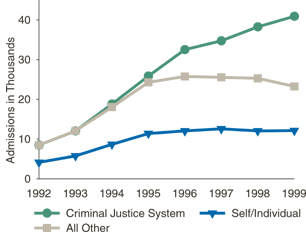

March 29, 2002 |
Treatment Referral Sources for Adolescent Marijuana Users |
In Brief |
|
| Marijuana was the most common drug of abuse among admissions of adolescents aged 12 to 17 reported to the Treatment Episode Data Set (TEDS) in 1999. The number of adolescent marijuana admissions increased 260 percent between 1992 and 1999. TEDS collects data on national admissions to primarily publicly funded substance abuse treatment facilities. "Admissions" represent annual treatment episodes rather than the number of individuals entering treatment. Generally, adolescents entered treatment through the intervention of another person or agency. The Treatment Episode Data Set (TEDS) collects information on the referral source for people entering substance abuse treatment in the public sector. TEDS defines the primary referral sources as follows: Court/criminal justice referral/DWI/DUI—police official, judge, prosecutor, probation officer or other person affiliated with a Federal, State, or county judicial system; court referral for DWI/DUI; referrals in lieu of or for deferred prosecution, during pretrial release, or before or after adjudication, pre-parole, pre-release, work or home furlough, TASC, or civil commitment Self- or individual referral—self-referral; family member, friend, or other individual School—school principal, counselor, or teacher; student assistance program, school system, or educational agency Other referral sources—substance abuse or health care providers; community, religious, or governmental organizations or agencies providing social services Trends in Referral Source
|
| Table 1. Percent Distribution of Adolescent Marijuana Admissions, by Referral Source: 1992-1999* | Figure 1. Number of Adolescent Marijuana Admissions, by Referral Source: 1992-1999 | |||||||||||||||||||||||||||||||||||||||||||||||||||||||||||||||
|
 |
|||||||||||||||||||||||||||||||||||||||||||||||||||||||||||||||
|
*1993 and 1995 not shown. SA=Substance Abuse; HC=Health Care. |
||||||||||||||
Source: 1999 SAMHSA Treatment Episode Data Set (TEDS). |
||||||||||||||
|
Referral Source by Sex
Among all adolescent marijuana admissions, there were three males for every female from 1994 to 1999. Among criminal justice referrals for marijuana abuse, the ratio was six males for every female in 1994. The ratio had declined to 4.5 to 1 by 1999 as more females were referred to treatment for marijuana abuse through the criminal justice system.
|
|
This page was last updated on December 31, 2008. |
|
SAMHSA, an agency in the Department of Health and Human Services, is the Federal Government's lead agency for improving the quality and availability of substance abuse prevention, addiction treatment, and mental health services in the United States. 
* PDF formatted files require that Adobe Acrobat Reader® program is installed on your computer. Click here to download this FREE software now from Adobe. |